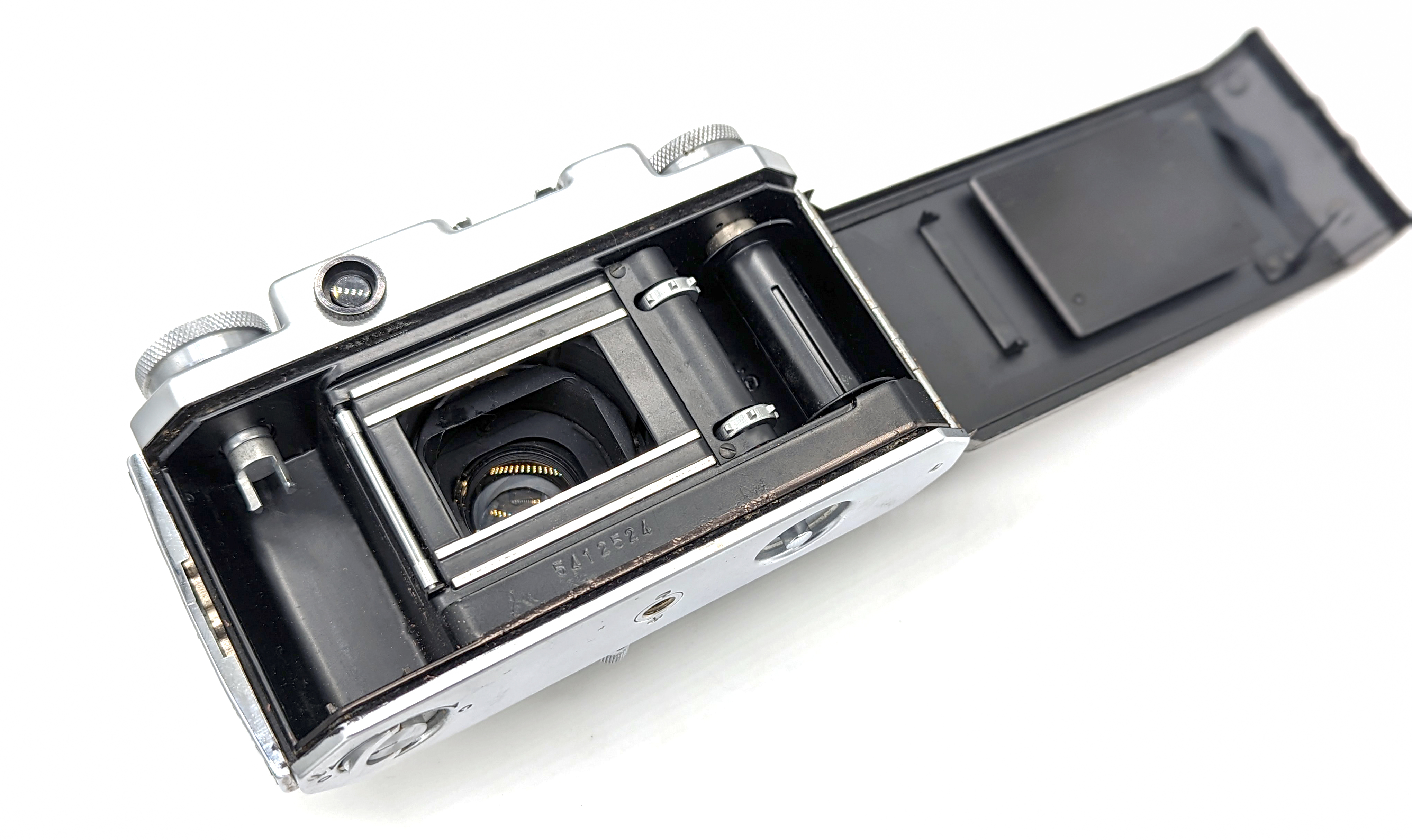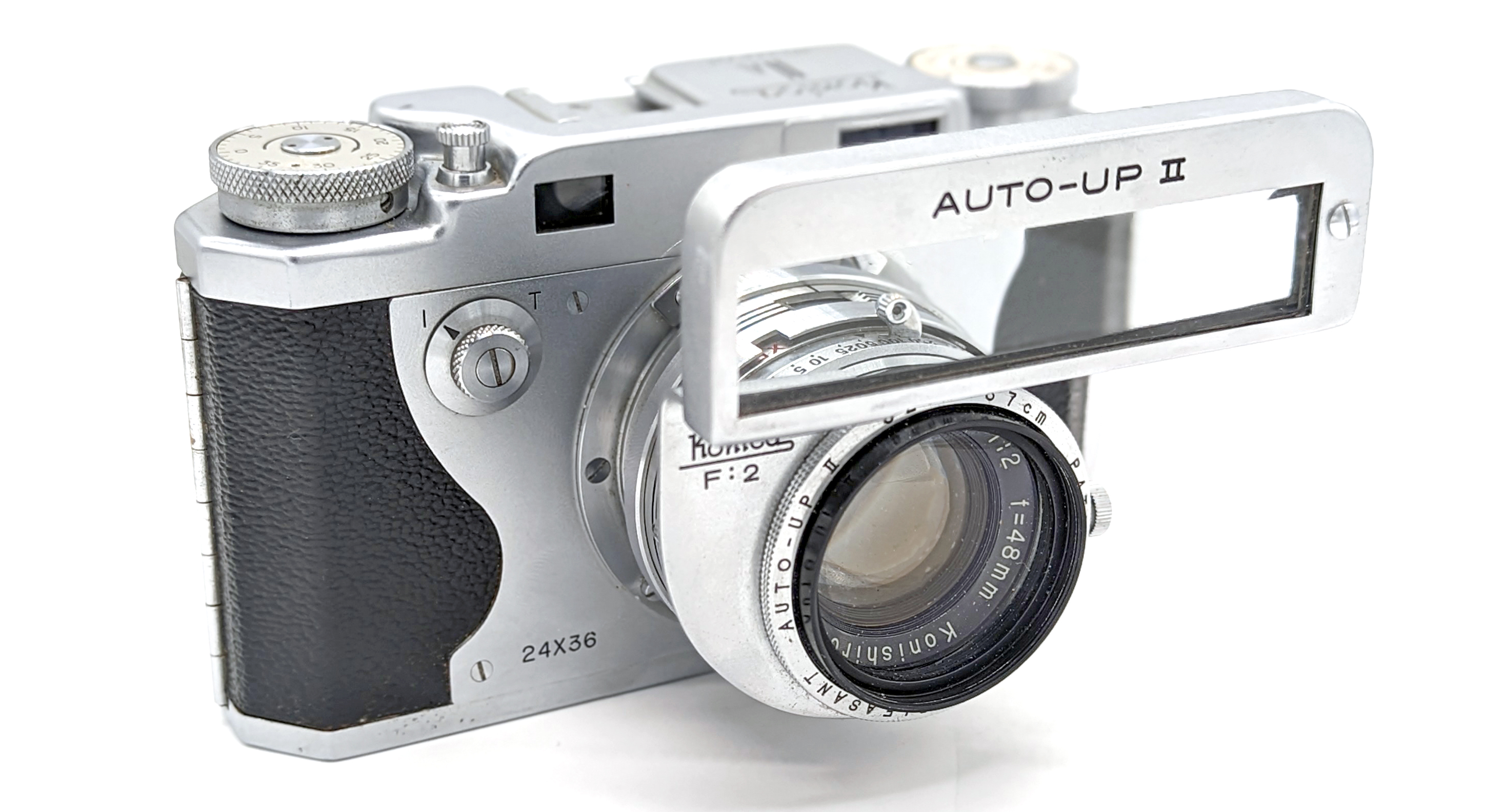
The stunning 1956 Konica IIA was the highest end model of the company’s popular 1951 “II” rangefinder series. Employing the fantastic 48mm f/2 Hexanon, a six element, five group lens with ten aperture blades, the IIA radiates the exceptional build quality and attention to detail of higher-end 35mm film cameras of the era. The largest drawbacks of the IIA include a relatively small viewfinder that lacks a frameline, a knob film advance, and the slightly cumbersome operation of the exposure settings and shutter. Otherwise, is the relatively-affordable, but slightly rare, IIA a good candidate for your meterless, standard-lens rangefinder needs? Let’s take a look.

Specifications of Konica II Models
| Model | Year | Lens | Lens Design | Blades | Shutter | Speeds | Filter |
| II | 1951 | 50mm f/2.8* Hexanon | Heliar Type; 5 Elements, 3 Groups | ? | Konirapid-S | B, 1 sec. – 1/500 | ? |
| IIB | 1955 | 50mm f/3.5** or f/2.8 Hexar | Tessar Type; 4 Elements, 3 Groups | ? | Konirapid-S | B, 1 sec. – 1/500 | ? |
| IIF | 1955 | 50mm f/2.8 Hexanon | Heliar Type; 5 Elements, 3 Groups | ? | Konirapid-MFX | B, 1 sec. – 1/500 | ? |
| IIA | 1956 | 48mm f/2 Hexanon*** | Ultron Type; 6 Elements, 5 Groups | 10 | Konirapid-MFX | B, 1 sec. – 1/500 | 35.5mm |
| IIBm | 1957 | 45mm f/3.5 Hexar | Tessar Type; 4 Elements, 3 Groups | ? | Seikosha-MX | B, 1 sec. – 1/500 | ? |
* A version of this lens was used in the 1952 Koniflex 6×6 TLR as the “85mm f/3.5 Hexanon.”
** The 50mm f/3.5 Hexar existed in a contemporary collapsible M39 version.
** The 48mm f/2 Hexanon existed in a contemporary rigid M39 version as the “50mm f/1.9 Hexanon” and was also used for the original 1956 Konica III rangefinder and initial versions of the IIIA.

Operation
The Konica II range of cameras have about 98% the same functionality, with the only notable differences among them being: (1) the lens employed; (2) whether the lens could partially collapse into the body; (3) the position of the shutter speed and aperture levers on the lens; and (4) whether camera contains the “I” / “T” switch on the front. Unlike the rest of the series, the IIBm placed the aperture dial window towards the front of the lens instead of at the 12 o’clock position near the base of the lens. The subsequent 1956 Konica III rangefinder line constituted a substantial modernization of the entire concept, including: (1) a double-stroke lever advance on the side of the lens that also cocked the shutter; (2) a larger, automatically parallax-correcting 1:1 viewfinder; (3) integrated strap lugs; (4) a modern exposure counter; (5) a folding rewind crank; (6) an external self-timer switch; and (7) a “light value” system that annoyingly couples the shutter speeds and aperture.
Film Loading, Advancing, & Rewinding: The IIA has a modern and easy-to-use film loading system via the standard swingback door and a locking mechanism on the bottom plate. Like other Konica products of the era, the pressure plate is large and does a good job keeping the film flat as possible on the focal plane. The advance knob is used to move the film along and then close the door and turn the lock on the bottom. Then advance the film two times and set the manual exposure counter at “0.” The II series has a mechanism that will lock the advance knob at the next frame so that you cannot over-advance the film. At the end of the roll, press the button on the bottom to unlock the mechanism and then use the rewind knob to respool the film.
No Strap Lugs: As with many other cameras from this era, the IIA does not have integrated strap lugs. The original camera case contained the lugs. Many good aftermarket cases exist today that will screw into the tripod amount and will allow the use of a standard camera strap. It is highly recommended to acquire and use an original or aftermarket case.
Viewfinder: While it could have been larger, the IIA’s bright and clear combined viewfinder / rangefinder is above average for an early-1950s fixed-lens camera. However, because the IIA was a mid-cycle product, Konica did not upgrade the 1951 viewfinder to conform with the world of 1956. With a slightly cool blueish tone, the viewfinder system uses a semi-transparent, triple-layer mirror that results in exceptional viewfinder brightness. When focusing, the large yellow rectangular rangefinder patch is yellow is aligned over a purplish image. The II series lacks a frameline or any parallax marks.
Lens: As an initial matter, you may have noticed that the II series does not precisely center the lens on the body, being just a little offset. The ten-bladed 48mm f/2 Hexanon is a world-class optic whose amber coatings work well for even modern color films. In 1956, it may have been the fastest lens put in a fixed-lens rangefinder camera. The six element, five group lens design is a derivative of the Voigtlander Ultron. There is no noticeable focus shift throughout the range, and the Hexanon is sharp from f/2 on. In my opinion, the 48mm Hexanon is as good as, or even better than, the best of contemporary 50mm rangefinder lenses, including the collapsible or rigid Leica 50mm f/2 Summicron. Konica would continue to deploy the 48mm f/2 in the III and initial versions of the IIIA rangefinders. I believe that the 50mm f/1.8 Hexanon found in the later IIIAs and the IIIM was a variation of this lens.
Shutter: The use of the Konirapid-MFX leaf shutter is from a brief period of time where Konica was producing its own leaf shutters (or at least contracting them out under its own name), which would then be outsourced to Seikosha later in the 1950s. It is incredibly quiet (certainly quieter than any Barnack or Leica M focal plane shutter) and quite elegant in operation. Like many cameras of the 1950s, it employs “older” style shutter speeds: 1/500, 1/250, 1/100, 1/50, 1/25, 1/10, etc. Keep the camera on the “I” setting for normal operation as “T” is for “time exposure.”
Taking a Photo: The aperture and shutter speed controls are on the lens itself. The aperture operation is really nice and has defined “click stops” at each full setting which can be viewed in a window at the 12 o’clock position when looking down onto the lens. Be sure to only change the shutter speeds with the shutter uncocked. To take a photo, advance the film with the dial until it stops. Then cock the shutter and trip the shutter (either via the top button or on the lens itself). Rinse and repeat. The focusing is performed via a knob around the lens and has a short, about 30-degree focus throw. Be careful not to wind the film and then press the shutter button before cocking the shutter.
Flash: The IIA has a PC sync port on the lens which will work with any appropriate electronic flash with a hot shoe adapter. You must move the flash indicator lever to display “X” in the cut-out window. With the leaf shutter, an electronic flash can sync at all shutter speeds.
Filters: Although Konica did produce some filters at the time (aka “Konifilters”), the IIA’s odd 35.5mm filter size is not really in use these days. The best option may be to use a step-up ring to 37mm or 39mm for a wider selection of modern multicoated filters.
Accessories: The IIA had several OEM accessories, such as a dedicated case, a Konica-branded clamp-in lens hood (the “Konihood”), and Konica-branded filters (“Konifilters”). None of these original OEM accessories are necessary as aftermarket cases, hoods, and modern multicoated filters can be used.
Auto Up II: A company called “Pleasant” produced an interesting accessory for the IIA that clamps onto the lens and over the rangefinder / viewfinder to permit a close focusing range of 0.52m down to 0.37m. The Auto-Up II itself has the same 35.5mm filter thread and can also be used with the Konica III rangefinder models with the same 48mm f/2 lens. The operation of the Auto Up II is somewhat inelegant as the accessory somewhat blocks the viewfinder through the middle of the frame. However, in the era before close-focusing SLR lenses, it was the best you could do.

Conclusions
The IIA is a product from an era when Konica was arguably at its best, also producing cameras like the Koniflex, the Pearl IV, and some fantastic lenses. While the IIA certainly has some drawbacks in the form of a lack of a frameline, an archaic shutter operation, a minimum focus of only 1.00m, and the lack of lever film advance, it remains a perfectly usable camera in the 21st century. My largest gripe with the IIA is the size of the viewfinder. While clear and contrasty, it remains a little squinty.
While the IIA is certainly preferable to the Konica I and a better overall choice to the II, IIB, or IIF models as a regular shooter, the more advanced III series is an alternative. While the IIA can be seen as a kind of a combined rangefinder-viewfinder, leaf-shutter, fixed-lens, easy-to-load alternative to a Barnack-style camera sporting a 50mm lens, the III can be seen as more of a combined rangefinder-viewfinder, leaf-shutter, fixed-lens, easy-to-load version of the Leica M3. Whether one would prefer a II or III would be a matter of personal preference; but having used both, I like the IIA as it occupies a particular niche while the III has some competition for its era and class of camera.
Of course, if you already have an M39 or M-mount camera that you enjoy, a better idea over the II or III rangefinders may be to just find a Leica screw mount Konica 50mm f/1.9 Hexanon, which is the same lens.
The IIA is superb. The design, build quality, weight, feel, operation are all fantastic. The only very slight downside is the difficulty in using the depth of field scale. The II makes this easier as the lens pushes out further from the body to give more room to read the scale.
Thanks for keeping this content posted. Excellent review. One of my favorites.
what aftermarket hood can I use for my 48mm/f2 konica iii lens? Thank you.
If the filter thread on your III is 35.5mm, you can use any cheap aftermarket hood with that size. Otherwise, you can get a step up ring to 37mm or whatever and use a 37mm hood.
Thank you very much for your kind reply.
[…] davidde.com […]